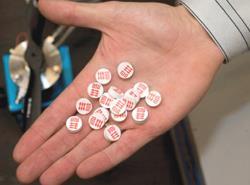Jens Nørskov and a team from the Technical University of Denmark have produced a fuel cell pellet which can hold over nine per cent hydrogen by weight.
The car of tomorrow could be powered by hydrogen - if only we can find a way to store it. The storage of hydrogen at high density and in a safe and convenient form for handling is a big problem facing energy researchers.

Jens N?rskov and a team from the Technical University of Denmark have produced a contender, in the form of pellets of a metal ammine complex (Mg(NH3)6Cl2) which can hold over 9% hydrogen by weight. The hydrogen is stored in the form of ammonia and can be easily released by heating. The release temperature can be altered by changing the composition of the complex and by using catalysts.
’The metal ammine complexes have the remarkable property that they can be compacted into a solid storage with a very high hydrogen content,’ said N?rskov. At 9.1% hydrogen, the pellets have a much higher storage capacity than other reversible systems found so far. They are stable up to 350 K and very easy to handle at room temperature. Their rate of ammonia leakage is so low that ’one cannot smell ammonia at room temperature even if one holds a pellet right under the nose,’ which should make the design of containers for storage and transport simple.
So what challenges remain? ’The down-side is that you need a catalyst to make hydrogen and this requires some energy,’ said N?rskov. ’It will be interesting to see how well one can use the heat generated in a fuel cell to help the hydrogen release along.’
Clare E Boothby
References
C H Christensen, R Z Sørensen, T Johannessen, U J Quaade, K Honkala, T D Elmøe, R Køhler and J K Nørskov, J. Mater. Chem., 2005, 15, 4106. (DOI: 10.1039/<MAN>b511589b</MAN>)






No comments yet